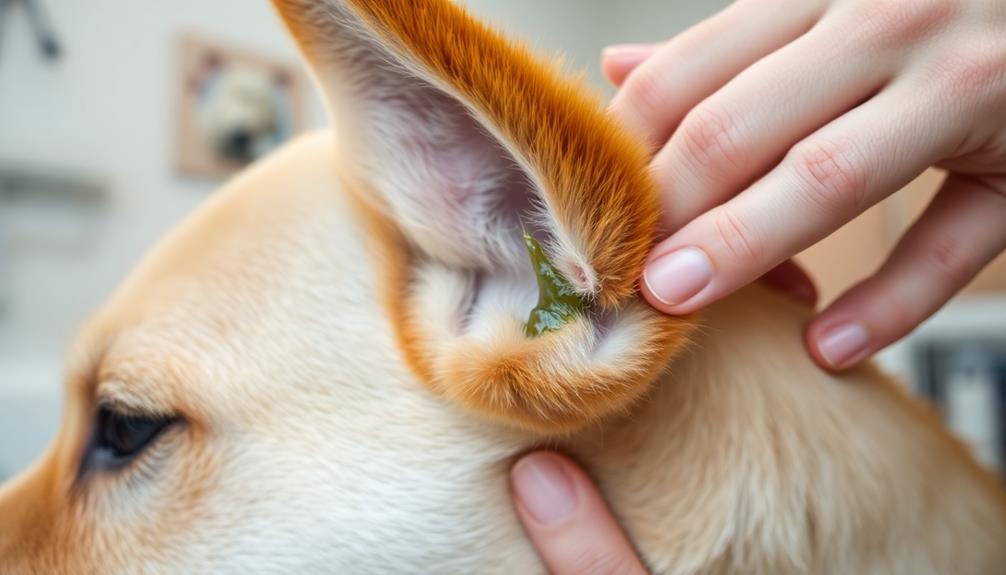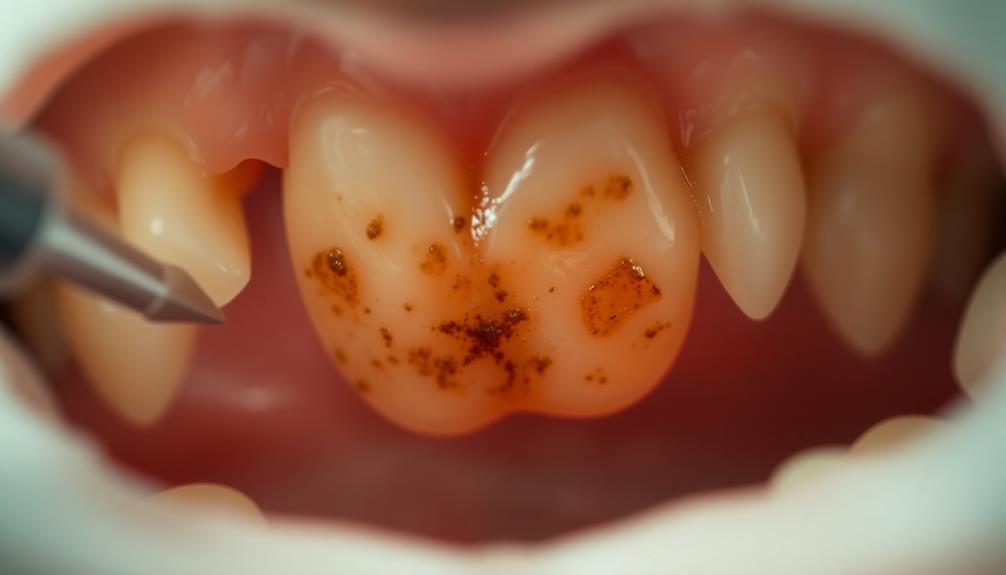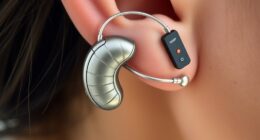If your dog has an ear infection, you'll likely notice a strong, unpleasant smell coming from their ears. This odor often signals that something's wrong, so pay close attention! Yeast infections create a sweet or musty smell, while bacterial infections produce a much stronger, more offensive odor. The smell can get worse as the infection progresses, sometimes accompanied by redness or discharge. It's crucial to act quickly, as untreated infections can lead to serious health problems. Keep an eye on your dog's ears, and if you notice any unusual odors, don't hesitate to seek vet assistance for answers!
Key Takeaways
- A dog ear infection often has a foul odor, indicating potential yeast or bacterial infection.
- Yeast infections typically produce a musty or sweet smell, while bacterial infections emit a strong, offensive odor.
- Mixed infections can create a complex smell from both yeast and bacteria, intensifying as the infection worsens.
- Floppy-eared breeds and those in humid environments are more prone to ear infections and associated odors.
- Unpleasant ear odors, redness, or swelling should prompt immediate veterinary consultation for proper diagnosis and treatment.
Introduction

If you've noticed a foul odor coming from your dog's ears, it could be a sign of an ear infection. This smell often indicates a yeast infection or, in some cases, a bacterial infection. Yeast infections can produce a sweet or musty scent, while bacterial infections tend to emit a stronger, more offensive odor.
It's essential to pay attention to these smells, as they often come with other symptoms. You might see redness, swelling, or itching in your dog's ears. Excessive scratching and head shaking could also point to discomfort. If your dog seems irritable or restless, the odor could be a clue that something's not right with their health.
Early detection is crucial, as ignoring these signs might lead to more serious issues. If you notice any unusual smells or symptoms, seeking veterinary assistance is a wise choice. A vet can help determine the type of infection and suggest effective treatments.
Description of the Smell

A peculiar odor from your dog's ears often signals an infection that shouldn't be ignored.
When your furry friend has an ear infection, the smell can be quite strong and unpleasant. You might notice a musty or sweet odor, which often means yeast is involved. On the other hand, bacterial infections can produce a more pungent, foul smell that you may detect from a distance.
As the infection worsens, the odor often becomes increasingly intense. You might also see signs like redness or discharge, which are key indicators that your dog's health is at risk. If there's a mix of infections, the smell can be quite complex, combining both yeast and bacterial scents.
If you notice any abnormal odor coming from your dog's ears, it's crucial to take action. This is a strong sign that veterinary attention is needed to diagnose and treat the underlying issue.
Regular ear cleaning can help prevent these infections, but if the smell persists, don't hesitate to consult your vet. Keeping an eye on your dog's ear health is essential for their overall well-being!
Source and Composition

The source of the unpleasant odor from your dog's ears often stems from a mix of biological factors. When your dog has ear infections, the smell can change based on what's causing the issue.
For example, yeast infections often lead to a musty or sweet smell due to the overgrowth of fungi, particularly Candida, in the ear canal. This can also cause redness and brown discharge.
On the other hand, a bacterial ear infection usually produces a strong, acrid odor. This smell comes from the decomposition of bodily tissues and the presence of pus, which may also cause swelling or bleeding. In some cases, the discharge accompanying the infection can be thick and yellowish or even green, further contributing to the unpleasant scent. If you’re wondering what an ear infection smells like, it typically resembles the scent of rotting or decaying materials due to the bacterial activity. Early detection and treatment are essential to prevent worsening symptoms and potential hearing damage.
If your dog has ear mites, you might notice a foul odor mixed with dark, waxy discharge, leading to excessive scratching and irritation.
Additionally, ear odor can arise from underlying conditions like allergies or excessive ear wax. This buildup creates a perfect breeding ground for bacteria and yeast, contributing to smelly ears.
Keeping an eye on your dog's ear health is essential, so regular check-ups can help prevent these issues and ensure your pet stays happy and healthy!
Typical Scenarios or Environments

Many dog owners notice that certain scenarios can significantly increase the risk of ear infections and the accompanying foul odor. For instance, high humidity during summer months or after swimming can cause moisture to build up in your dog's ears. This moisture is a common reason why dogs' ears stink, leading to infections.
Floppy-eared breeds, like Cocker Spaniels and Basset Hounds, are especially prone to ear problems. Their ear structure traps moisture and debris, making it easier for bacteria and yeast to thrive.
If your dog has allergies, that can also raise the likelihood of ear infections, especially when combined with allergens like pollen or mold.
To help prevent these issues, cleaning your dog's ears regularly is crucial. Make it a habit to check their ear canals and remove any debris or wax.
If you notice a strong, unpleasant smell, it's time to take your dog to the vet. Staying proactive about your dog's ear health can save you from dealing with those pesky infections and help keep your furry friend feeling their best!
Emotional or Cultural Associations

Noticing a foul smell emanating from your dog's ears can stir up a mix of worry and guilt. That strong, unpleasant odor often signals an ear infection, which can be distressing for both you and your furry friend.
Many pet owners feel a sense of embarrassment, thinking it reflects their pet hygiene practices. In various cultures, the health and cleanliness of dogs are closely linked to the owner's responsibility, leading to emotional stress when issues arise.
Some might see ear infections as a common part of pet ownership, while others feel it indicates poor care. It's essential to understand that these infections can happen to any dog.
Being aware of the typical smell can help you approach pet health care more proactively. Emphasizing regular check-ups and hygiene practices can prevent these issues before they start.
Remember that your bond with your dog is crucial, and addressing any health concerns can strengthen that relationship.
Health or Safety Considerations

How can you ensure your dog's ears stay healthy and free from infection? First, pay attention to any foul odor coming from your dog's ears. A strong smell might indicate an infection in your dog, which could be yeast or bacteria. If you notice a bad smell, it's essential to see a vet promptly to avoid complications.
Additionally, maintaining a balanced diet that includes safe fruits like apples can contribute to your dog's overall health, supporting a strong immune system that can help fend off infections safe fruits for dogs.
Regular ear cleanings are crucial, especially for dogs with floppy ears, which can trap moisture and dirt. Make it a routine to check your dog's ears frequently. Look for signs of discomfort, like excessive scratching or head shaking, as these can worsen the infection.
If you spot foul-smelling discharge, monitor its color and consistency, as this can signal the severity of the infection.
Don't forget the importance of regular veterinary check-ups. These check-ups can help you catch any potential issues early, making it easier to keep your dog's ears healthy.
Final Thoughts

In conclusion, keeping your dog's ears healthy is vital for their overall well-being. Ear infections can lead to foul odors, often a sign of bacteria or yeast growth. To prevent this, make sure you have your dog's ears checked regularly.
Regular maintenance and cleaning help avoid the buildup of wax and moisture that attracts infections. If you notice an unusual odor, redness, or swelling, it's important to consult your vet right away. They can determine if there's a foreign object causing the issue or if your dog needs ear drops for treatment.
Don't wait too long, as untreated infections can lead to more serious problems. To keep your dog happy and healthy, set a routine for checking and cleaning their ears. Use a vet-recommended cleaner to ensure you're doing it safely.
Remember, a little effort now can prevent discomfort and costly vet visits later. By staying proactive, you can help your furry friend enjoy a life free from ear infections and those unpleasant odors.
Frequently Asked Questions
What Does a Bad Ear Infection Smell Like?
When your dog has a bad ear infection, you'll notice a strong, unpleasant odor. It might be putrid or musty, signaling a potential issue that requires your immediate attention and a visit to the vet.
How Can I Tell if My Dog Has an Ear Infection?
To tell if your dog has an ear infection, watch for signs like excessive scratching, head shaking, or redness. You might also notice discharge or swelling. If symptoms persist, consult your vet for help.
What Does a Dog Bacterial Infection Smell Like?
When your dog has a bacterial infection, you'll notice a strong, foul odor emanating from their ears. This smell often indicates severe inflammation, so it's crucial to seek veterinary care immediately for proper treatment.
How Do You Treat an Ear Infection in a Dog Without Going to the Vet?
You can try cleaning your dog's ears with diluted apple cider vinegar and applying warm compresses for comfort. However, always monitor for worsening symptoms and consult a vet if issues persist or worsen.









